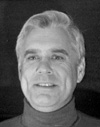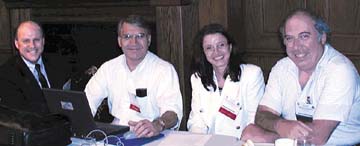
 |
TC-9 Computational EMCTwo Modeling Workshops Draw International Crowd at EMC Symposium |
By Colin E. Brench |
The EMCS Technical Committee Nine (TC-9) meets each year during the Symposium to discuss the activities of the past 12 months and to plan for the up coming year. The charter of this TC is very wide and encompasses all aspects of applied computational electromagnetic techniques as used to model electromagnetic interactions in circuits, devices, and systems. A primary focus is the identification, development and validation of modeling methods that are well suited to EMC phenomena. Along with this is the very practical side of defining the applicable limits for these methods and providing the society with an educational resource as needed to encourage the development of the field. Included are low and high frequency-domain techniques as well as time-domain methods.
 |
Members of Technical Committee Nine on Computational EMC (TC-9)
gathered during the EMC symposium in Washington, DC. Pictured left to right are TC-9
Chairman Jim Drewniak of the University of Missouri at Rolla, committee member Franz Gisin
of Nortel Networks, TC-9 Vice-Chair Zorica Pantic-Tanner of San Francisco State
University, and Bruce Archambeault of IBM who maintains the committee's modeling website.
|
This year, as in the past, TC-9 organized two modeling workshops at the Symposium that provided basic training and insight into the world of computational electromagnetics. These two workshops vary only slightly from year to year. The Monday session focused on the basic numerical techniques while the Friday session examined simple applications designed to highlight the use of the various techniques. In addition, TC-9 organized sessions dedicated to modeling throughout the main part of the Symposium including an invited papers session. The goal for this session of invited papers was to highlight significant advances in the field.
Quite apart from the direct TC-9 sessions, many other sessions included papers that relied heavily upon numerical modeling. In particular, a session on measurement antennas provided many examples of how the inclusion of computational electromagnetics can improve the accuracy of the most fundamental EMC tasks – performing verification measurements. By improving basic site models and including specific antenna details, it was shown that over all measurement uncertainty can be significantly reduced. This is a most important area of research as it allows for less over design and greater repeatability, both of which can translate to potential cost savings.
In the planning for next year it was observed that the basic workshops were well attended, and feedback indicated that these workshops were targeted appropriately for those just beginning to become interested in modeling EMC problems. The Committee has many enthusiastic members who offered a wide variety of suggestions for expanding the role of TC-9 in the coming year. One of the most popular thoughts was the inclusion of modeling demonstrations as part of the experiment sessions. This would permit engineers to get a first hand view of what can be done.
The activities of TC-9 that continue throughout the year include a column in the EMCS Newsletter and a web site that provides detailed information on reference modeling problems. TC-9 also provides technical expertise for reviewing papers submitted to the IEEE and other EMC symposia that are primarily based in computational electromagnetics.
The EMCS Newsletter column provided basic modeling information and reported on related conferences. It will be replaced in the future with full-length articles on computational electromagnetics in EMC that will have a wider appeal.
The TC-9 web site is an ongoing effort. This site is a joint effort between the Applied Computational Society (ACES) and the IEEE EMC Society TC-9 subcommittee. The purpose of the web site is to provide data for EMC modeling validation. Measurement data and modeling data will be provided with enough detail so the user can repeat the work, and compare new results to previous results. In addition to the test/model data results, a section is provided for 'standard' EMC modeling problems. These problems have been documented with sufficient detail so that a user can easily create these models, and potentially analyze commercial or new software codes for their ability to perform meaningful EMC simulations.
TC-9 has an international membership and within this Committee expertise can be found in a very wide range of numerical techniques, application and validation methodologies. The members of this Committee are dedicated to the promotion of EMC modeling in all its aspects, and welcome all suggestions for how this can be most effectively achieved. Please contact one of the members listed below with your comments or suggestions.
Contacts:
Colin Brench, EMCS Newsletter
TC-9 Column Contributor,
colin.brench@compaq.com
Jim Drewniak, TC-9 Chairman,
drewniak@ece.umr.edu
Bruce Archambeault, EMC/EMI modeling web page,
barch@us.ibm.com
EMC